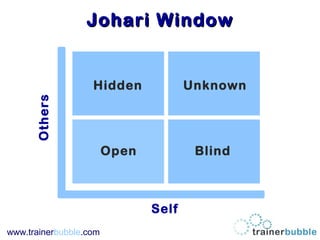
160 johari window
- 1. www.trainerbubble.com Johari WindowJohari Window Self Others Hidden Unknown Open Blind
- 2. www.trainerbubble.com Open Area - What is known by the person about him/herself and is also known by others Blind Area - what is unknown by the person about him/herself but which others know Hidden Area - what the person knows about him/herself that others do not know Unknown Area - what is unknown by the person about him/herself and is also unknown by others
- 3. www.trainerbubble.com Purpose Helps you to gain an understanding and appreciation of how effective feedback and self-disclosure can improve communication skills.
- 4. www.trainerbubble.com What is Johari Window? 1. Named after the first names of its inventors – Joseph Luft & Harry Ingham 2. Communication window relating to giving and receiving information 3. A useful model describing the process of human interaction
- 5. www.trainerbubble.com Description This model suggests that a person’s self is composed of several parts, which are represented by the four panes of a window. Through the window we can look at the different parts of our self. Luft and Ingham observed that there are aspects of our personality that we're open about, and other elements that we keep to ourselves. At the same time, there are things that others see in us that we're not aware of. As a result, you can draw up a four-box grid, which includes a fourth group of traits that are unknown to anyone. The application of the Johari Window comes in opening up the public area, so making the other three areas as small as possible. This is done by regular and honest exchange of feedback, and a willingness to disclose personal feelings. People around you will understand what "makes you tick", and what you find easy or difficult to do, and can provide appropriate support. And of course you can then do the same for them.
- 6. www.trainerbubble.com Description This model suggests that a person’s self is composed of several parts, which are represented by the four panes of a window. Through the window we can look at the different parts of our self. Luft and Ingham observed that there are aspects of our personality that we're open about, and other elements that we keep to ourselves. At the same time, there are things that others see in us that we're not aware of. As a result, you can draw up a four-box grid, which includes a fourth group of traits that are unknown to anyone. The application of the Johari Window comes in opening up the public area, so making the other three areas as small as possible. This is done by regular and honest exchange of feedback, and a willingness to disclose personal feelings. People around you will understand what "makes you tick", and what you find easy or difficult to do, and can provide appropriate support. And of course you can then do the same for them.
